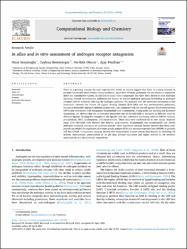| dc.contributor.author | Serçinoğlu, Onur | |
| dc.contributor.author | Bereketoğlu, Ceyhun | |
| dc.contributor.author | Olsson, Per-Erik | |
| dc.contributor.author | Pradhan, Ajay | |
| dc.date.accessioned | 2021-06-29T10:15:28Z | |
| dc.date.available | 2021-06-29T10:15:28Z | |
| dc.date.issued | 2021 | en_US |
| dc.identifier.citation | Serçinoğlu, O., Bereketoglu, C., Olsson, P.-E., Pradhan, A. (2021). In silico and in vitro assessment of androgen receptor antagonists. Computational Biology and Chemistry, 92, art. no. 107490.
https://doi.org/10.1016/j.compbiolchem.2021.107490 | en_US |
| dc.identifier.uri | https://doi.org/10.1016/j.compbiolchem.2021.107490 | |
| dc.identifier.uri | https://hdl.handle.net/20.500.12508/1797 | |
| dc.description.abstract | There is a growing concern for male reproductive health as studies suggest that there is a sharp increase in prostate cancer and other fertility related problems. Apart from lifestyle, pollutants are also known to negatively affect the reproductive system. In addition to many other compounds that have been shown to alter androgen signaling, several environmental pollutants are known to disrupt androgen signaling via binding to androgen receptor (AR) or indirectly affecting the androgen synthesis. We analyzed here the molecular mechanism of the interaction between the human AR Ligand Binding Domain (hAR-LBD) and two environmental pollutants, linuron (a herbicide) and procymidone (a pesticide), and compared with the steroid agonist dihydrotestosterone (DHT) and well-known hAR antagonists bicalutamide and enzalutamide. Using molecular docking and dynamics simulations, we showed that the co-activator interaction site of the hAR-LBD is disrupted in different ways by different ligands. Binding free energies of the ligands were also ordered in increasing order as follows: linuron, procymidone, DHT, bicalutamide, and enzalutamide. These data were confirmed by in vitro assays. Reporter assay with MDA-kb2 cells showed that linuron, procymidone, bicalutamide and enzalutamide can inhibit androgen mediated activation of luciferase activity. Gene expression analysis further showed that these compounds can inhibit the expression of prostate specific antigen (PSA) and microseminoprotein beta (MSMB) in prostate cell line LNCaP. Comparative analysis showed that procymidone is more potent than linuron in inhibiting AR activity. Furthermore, procymidone at 10 mu M dose showed equivalent and higher activity to AR inhibitor enzalutamide and bicalutamide respectively. | en_US |
| dc.language.iso | eng | en_US |
| dc.publisher | Elsevier | en_US |
| dc.relation.isversionof | 10.1016/j.compbiolchem.2021.107490 | en_US |
| dc.rights | info:eu-repo/semantics/openAccess | en_US |
| dc.subject | Helix 12 | en_US |
| dc.subject | Antiandrogen | en_US |
| dc.subject | Prostate | en_US |
| dc.subject | Endocrine disruption | en_US |
| dc.subject | Pollutants | en_US |
| dc.subject.classification | MDV 3100 | |
| dc.subject.classification | Androgen Receptors | |
| dc.subject.classification | Castration | |
| dc.subject.classification | Biology | |
| dc.subject.classification | Computer Science | |
| dc.subject.classification | Interdisciplinary Applications | |
| dc.subject.other | Alters sexual-differentiation | |
| dc.subject.other | Reporter gene assays | |
| dc.subject.other | Molecular-dynamics | |
| dc.subject.other | Male-rat | |
| dc.subject.other | Risk-assessment | |
| dc.subject.other | Rainbow-trout | |
| dc.subject.other | Linuron | |
| dc.subject.other | Procymidone | |
| dc.subject.other | Endocrine | |
| dc.subject.other | Pesticides | |
| dc.subject.other | Antigens | |
| dc.subject.other | Binding energy | |
| dc.subject.other | Cell culture | |
| dc.subject.other | Diseases | |
| dc.subject.other | Gene expression | |
| dc.subject.other | Pollution | |
| dc.subject.other | Urology | |
| dc.subject.other | Androgen receptor antagonists | |
| dc.subject.other | Comparative analysis | |
| dc.subject.other | Environmental pollutants | |
| dc.subject.other | Gene expression analysis | |
| dc.subject.other | Ligand binding domain | |
| dc.subject.other | Luciferase activities | |
| dc.subject.other | Prostate specific antigen | |
| dc.subject.other | Reproductive systems | |
| dc.subject.other | Ligands | |
| dc.title | In silico and in vitro assessment of androgen receptor antagonists | en_US |
| dc.type | article | en_US |
| dc.relation.journal | Computational Biology and Chemistry | en_US |
| dc.contributor.department | Mühendislik ve Doğa Bilimleri Fakültesi -- Biyomedikal Mühendisliği Bölümü | en_US |
| dc.identifier.volume | 92 | en_US |
| dc.relation.publicationcategory | Makale - Uluslararası Hakemli Dergi - Kurum Öğretim Elemanı | en_US |
| dc.contributor.isteauthor | Bereketoğlu, Ceyhun | |
| dc.relation.index | Web of Science - Scopus - PubMed | en_US |
| dc.relation.index | Web of Science Core Collection - Science Citation Index Expanded | |
















